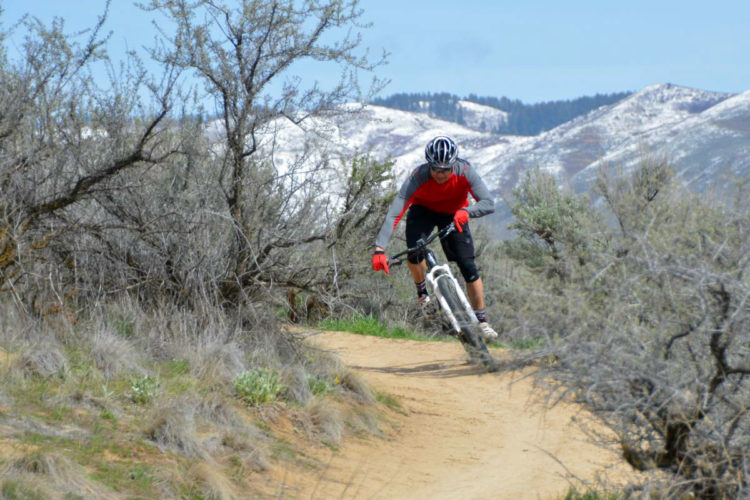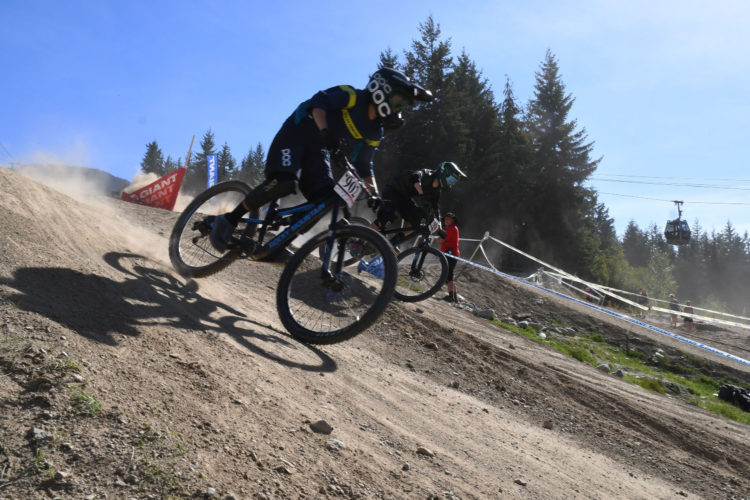
For mountain bikers who follow the endurance and cross-country scene, Jeremiah Bishop is no stranger. Bishop has competed in the most well known stage race in the world, the Absa Cape Epic, won stages in the TransAlp Challenge, and regularly competes in (and wins) some of the most competitive stage races in North America, like the Pisgah Stage Race, Trans-sylvania Epic and Breck Epic. He’s also won numerous NORBA National titles and other cross-country mountain bike races across the nation.
Although Bishop is still racing regularly, he’s transitioned to a staff and ambassador role for Canyon. He travels the East Coast and helps run demos and rides for Canyon bikes and gets people excited about riding.
We caught up with Bishop for our second installment in the Pro Skills series to pick his brain about power development for mountain biking.
What do you spend the most time doing that is bike-related, but isn’t riding?
Definitely doing administrative stuff. I have a new role with Canyon where I manage Canyon’s East Coast events. We do everything from demos, to races, expos, to Canyon Experiences. We’ve got a truck, trailer, and 40 bikes. We travel up and down the East Coast doing that. That’s a ton of work. Trying to race on top of that has really been a challenge. I’m doing a bit of everything now – gravel, road, and mountain.
I’m still coaching a little bit, mostly doing training plans. They’ll cover anything from stage racing to cross-country to the Leadville 100 and those different training plans have a different focus. If you’re doing something like BC Bike Race, you want to focus on skill, strength development. If you’re doing something like Leadville 100, you’d want to take that same focus to acclimating to altitude, pacing, nutrition, and some of the aspects that help for the long distance of Leadville. [Each plan is] really targeted. I really enjoy it. It’s kind of a blend of art and science that I’ve had to blend over the years to do what I do on the mountain bike.
After being an athlete for decades, what motivates you to continue getting out there daily, even when you’re not motivated?
To be honest, being out of shape and getting beaten. [He laughs]. A lot of it is that I know, even if I do a little bit, I can maintain. If I get out there, I always have a great time. Usually, you hold yourself back more mentally than physically. When I don’t feel like riding, which has been more frequently than ever with an injury to my knee, and my new job, and now I’m not necessarily a full-time professional cyclist, and working in the bike industry all day on bikes, when you get done, you don’t necessarily want to ride. It’s a real balancing act.
Also, having a race goal keeps me motivated. […] Say, I have a race goal that’s looming and it’s three weeks out and I think of that, that keeps me honest and keeps me out there when I don’t feel like it. Just having that goal on a Post-It on your computer or somewhere in your office, that can be a visual reminder of how important it is to you.
With a lack of race goals, it can be kind of nebulous. Then it’s just about trying to be your best and be fit. Being fit feels good.
Power
What is power and why is it important for mountain biking?
Power is work over time, so when someone thinks of a powerful rider like Braydon Bringhurst who did the really awesome edit in Moab on the [Canyon] Spectral. He’s an extremely powerful rider, comes from pole vaulting, and was a track and field athlete turned mountain biker.
His neuromuscular power, you can just see it when he is smashing up these inclines, he’s got this explosiveness. If we were to do a standing sprint, he would wax me. If we were talking about sustained aerobic power like in the Tour de France, that could be a different thing.
Peak power is highly trainable through efforts off-the-bike and by sprints on the bike. That’s a weakness for me honestly, so I do plyometrics. Kettlebell step-ups are one of my favorites, plyometric jumps, I’ll do a bunch of exercises that are specific to peak muscle recruitment — when you’re recruiting fast and slow twitch muscle fibers simultaneously.
When you’re doing explosive starts like in a four-cross or slalom, you’re going to gain seconds if you can get off the line really powerfully. My biggest recommendation is strength training, especially working with heavier weights with plyometrics.
Working on your strength in the off-season and in-season pays big dividends. I suggest at least one day a week in-season, and two or three days a week in the off-season. It really pays off if you have some focus on force development, whether it’s sprints on the bike or squats or speed squats at the gym.
How does building peak power differ from building a stronger pace?

Your climbing ability is usually your steady state aerobic output. Say you’re doing a big climb, like a huge road climb. That is aerobic capability. The best way train that is through shorter blocks of full power. You can train endurance by doing long rides, but you can also train specific power that you’re looking to put out.
Last year prior to BC Bike Race, at Breck Epic I was trying to get my one minute power back up to 400 watts. So instead of trying to do 20 minute blocks at 400, I would do six minute blocks at 400-415 watts. That’s training my aerobic and muscular system to really stretch to improve my level. That’s one of my key movements to build threshold power.
Is riding in a higher gear a good way to build power?
You could do gear intervals [to build power] for shorter, explosive efforts as well as long, sustained climbs. That’s another variation for shorter and longer efforts. What it does is recruits more fast twitch muscle. The irony is that fast-twitch muscle is not speed dependent. […] For example, if you put [your bike] in a really hard gear from a stand still, that recruits a lot more fast twitch. That’s a great training tool. I’ll do big gear hills like that at the end of a long ride to train neuromuscular recruitment and muscular endurance.
But, if you do big gear work, then you need to do high cadence work to balance it out. For anybody that watches mountain bike racing, especially endurance mountain bike racing, you’ll see a lot of variability in cadence. Someone might be spinning a big gear on a climb, but then they hit the flats and they’ll be spinning or maybe just spinning on the climbs and pushing a big gear on the flats. A lot of that has to do with just changing your muscle groups and getting good circulation going.
I’ll do single-leg drills, fast pedaling drills, which I’ll do 120-140RPM for a minute. That’s really good to balance the sluggish cadence and re-train your muscles to turn over quickly.
How long can you usually maintain a maximum amount of power?

That’s really defined by physiology. You have different energy systems that work in different durations. Fourteen seconds is about where most people can sprint. Top sprinters can extend that for close to 20 seconds.
I can’t really hold much more than 20 seconds for a really peak power sprint and then power will fade quite a bit to peak one-minute power. I could do between 600 and 650 watts for a minute, but then you have to rely on aerobic power after that and it drops a lot.
Why is core important for power?
Core exercises help with transmission of power to the bike. With mountain biking you want to do a lot of dynamic movements too. I’ll do sandbag squats standing on a Bosu ball, which is hard enough on its own until you’ve got it figured out. Then, I’ll add a 40lb sandbag. That’s really challenging, but you’ll train all your little stabilizer muscles that you need for descending.
There’s the obvious, that if you do sprint work or explosive movements in the gym you’ll get more power on the bike, but there’s a transmission element that’s really key to convey. You might do your seated rows at the gym or pullups, or squats, but the weakest link is where you’ll lose the most power.
A little bit every day is an easy way to do it. It’ll help with power transmission and keep your lower back strong. The core work I’m talking about is not the six-minute abs bullshit; you’ll get the Olympic athletes that are kind of barrel chested. I’ll do a lot of stuff that targets stabilization, or something that targets the psoas [muscle].
I’ll do a five minute plank variation and take a 5lb weight and basically do front planks, slide the plate on the ground, then I’ll do side planks on my elbows, reach for the weight under my armpit and then up over my head like a T, then back under my armpit.
Anytime you add movement and challenge stability, it becomes really good for sport performance.
[see_also id=’255790′]
Takeaways to build power

- Power is highly trainable on and off the bike.
- Use resistance training or plyometrics to build peak (sprinting) power.
- Use interval work to build a stronger pace. For example, pedal at 100+ RPM for 1-2 minutes, recover at around 90 RPM for 1-2 minutes. Increase interval and recovery length with time.
- Use a higher gear than normal on a notable climb.
- Maximum power is sustainable for very short periods of time.
- Train your core for efficient power transfer on the bike.
Thanks to Jeremiah for sharing his tips for increasing power on the bike.



















